How To Grow Huge Yields Of Cannabis Using DWC Hydroponics
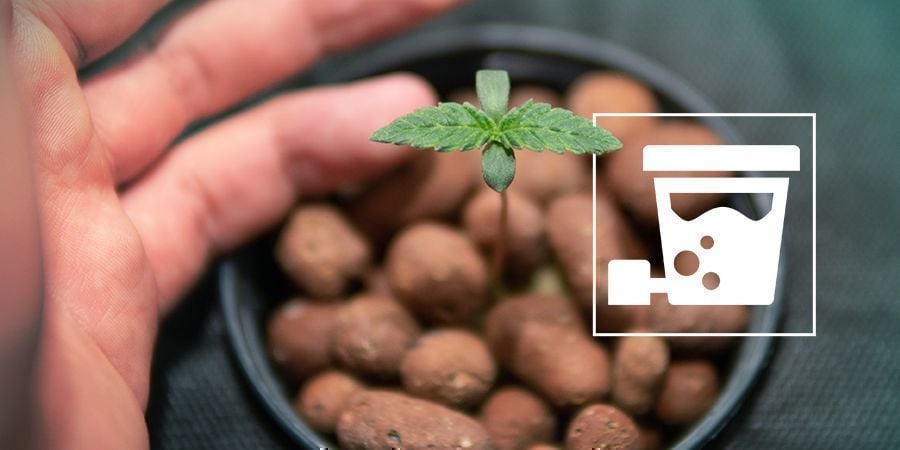
Abundant yields in less time with fewer resources? This is the promise of growing cannabis in a hydroponic system. When it comes to deep water culture (DWC), what are the benefits and drawbacks? And furthermore, how can you set up your own DWC grow at home?
Amongst all forms of hydroponics, the premise is generally the same: you grow your crops without soil, instead relying on an inert medium for structural support, with nutrient-rich, oxygenated water coming into direct contact with the root system. Deep water culture or direct water culture (DWC) is a popular hydro system amongst cannabis cultivators, largely due to its convenience and lack of extensive equipment. If performed correctly, DWC is capable of supporting larger yields of higher-quality bud.
Let’s take a look at the pros and cons of this method, before examining how to set up a DWC hydro system at home! For more information on advanced hydroponic methods, be sure to check out our guide on the subject.
WHAT IS DWC?
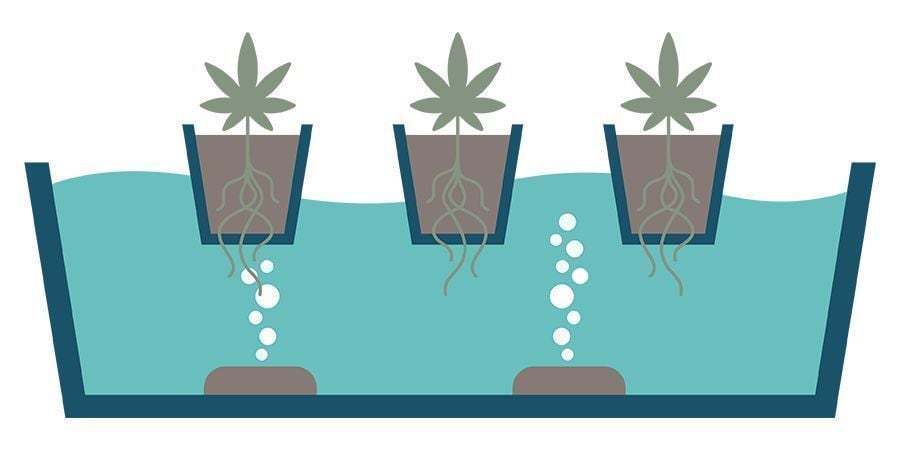
In DWC, the roots of your cannabis plants grow down through an inert medium into a reservoir of nutrient-rich, oxygenated water. Roots stay submerged in the reservoir from the time they first make contact, all the way to harvest day.
The plants themselves are suspended in net pots, where a soilless growing medium provides structural support and helps maximise efficiency of the root system below. The water reservoir is equipped with an air stone to keep things healthy, and nutrients are fed directly into the water for max absorption by the roots.
PROS OF DWC HYDROPONICS
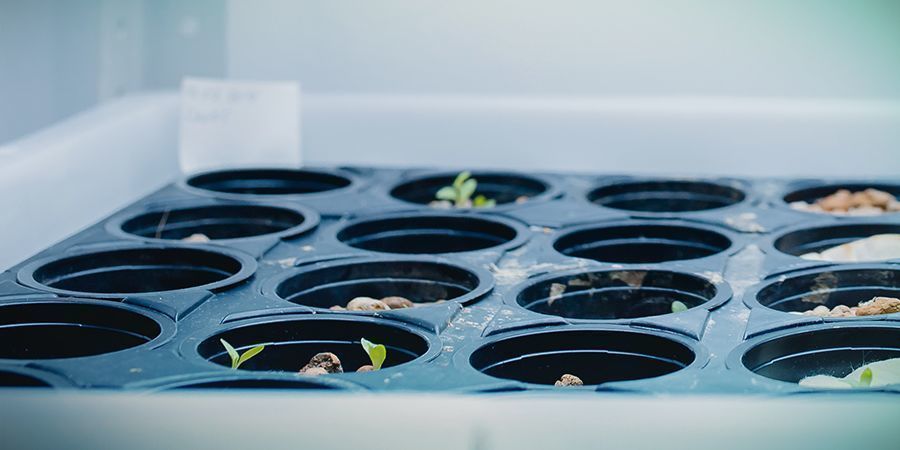
Each hydro setup comes with its own pros and cons, although DWC is considered to be one of the easiest methods, especially for beginners.
First of all, it is relatively easy to set up and customise according to your specific needs. It works with any cannabis growing facility, from a small home system with one or two plants to large grow-ops with hundreds of specimens.
Secondly, in a DWC system, your cannabis plants will grow significantly faster. Having everything they need at their disposal, your green babies won’t waste any time or energy developing an extended root system, instead dedicating more resources to stem, branch, and foliage development.
Moreover, the lack of soil means a much lower chance of root-borne diseases and pests; also, no weeds will make it into the medium.
The result of the above benefits is, of course, a higher yield. Some cannabis growers report up to a 20% increase in yield after switching from soil to DWC.
You will also use less water compared to growing in soil, and will have more control over all the essential factors of your growing environment. Since everything is calibrated and controlled to the max in a DWC grow system, you will avoid unnecessary waste of resources. Plus, all of this can be automated with the help of sensors and timers, making DWC a great option for growers who need to leave their plants alone for extended periods.
CONS OF DWC HYDROPONICS

As they say, all that glitters ain’t gold. DWC also comes with some drawbacks.
If you choose to grow your weed using deep water culture, it is advisable to invest in some decent equipment to get the most out of it. This includes timers, a reliable pump, a PPM meter and pH control, as well as high-quality lighting. This will cost you a decent chunk of change outright, which means it’s not as budget-friendly as, say, an outdoor grow in soil.
Regarding temperature, keep in mind your plant's roots are particularly sensitive to any changes in the water or the air. A non-recirculating deep water culture system will make it difficult to maintain an ideal temperature. The pump continuously runs in the water, increasing its temperature, with the grow lights above also contributing to the overall heat.
Not only that, but one of the biggest “threats” in a DWC system is pH fluctuation. Since there is no soil medium to buffer nutrients, plants are much more susceptible to wild pH swings and issues that follow. Small swings aren’t always the end of the world, but they can increase the length of your grow or confuse/stress-out novices unfamiliar with this issue.
As we recommended above, an automated system makes running a DWC much easier. Without automation, this system requires near-constant upkeep to maintain ideal parameters. That said, not only does automation require some investment and know-how, but also power. Your electricity bill might take a hit, and if a blackout occurs, your crops will suffer. Consider a backup air pump in case of possible system failures.
5 EASY STEPS TO BUILD YOUR OWN DWC SYSTEM
When setting up a DWC grow, the essential premise is that you should cater the system to your unique needs. That means, only source the materials you need for the amount of plants you’re going to grow. While practically any cannabis strain can be grown in deep water culture, those that are robust, medium-sized, and can withstand a little pH fluctuation are arguably the best candidates.
Below is a 5-step guide to building out your own DWC growing system. Each step “zooms in” on an essential component of the system, explaining how you should go about setting it up for best results.
STEP 1: RESERVOIR
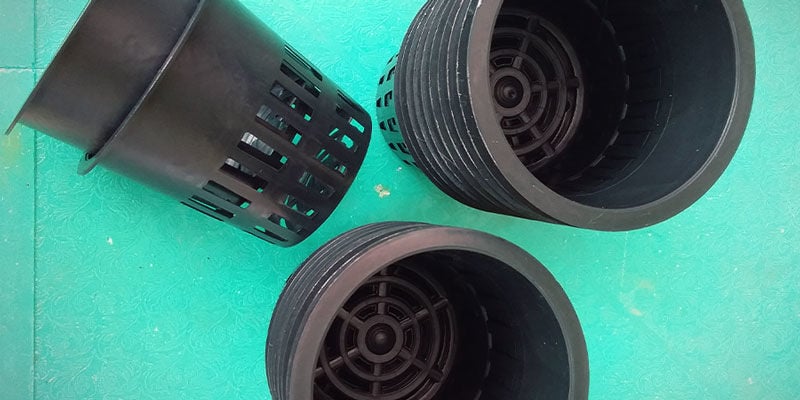
In DWC, you have a reservoir filled with nutrient- and oxygen-rich water. Calculate about 5 litres of water per plant, and be ready to observe and top up your solution regularly.
The solution must maintain a pH between 5.5 and 6.5, although the ideal reading is 5.8. The pH level affects how well your plants are able to absorb the nutrients. It is also phase-specific: the higher end of the above-mentioned range will be suitable in the seedling and vegetative stages, while a lower pH level is preferable during the flowering stage.
Also, temperature must be carefully set and maintained. Ideally, the reservoir should remain at a temperature between 17–20°C. Keep in mind that your lamps will most likely contribute to the heat of the grow room too. You will probably need a proper venting/exhaust system to keep the overall temperature at an optimal level.
Before setting up your reservoir, make sure to vacuum and disinfect your grow room to avoid any germs, bacteria, mould, or dust. Also, be sure to calculate enough space for your plants to stretch and bloom during the flowering stage. To keep plants from competing too much for resources, we recommend no more than a couple of plants per home DWC tent.
STEP 2: OXYGEN
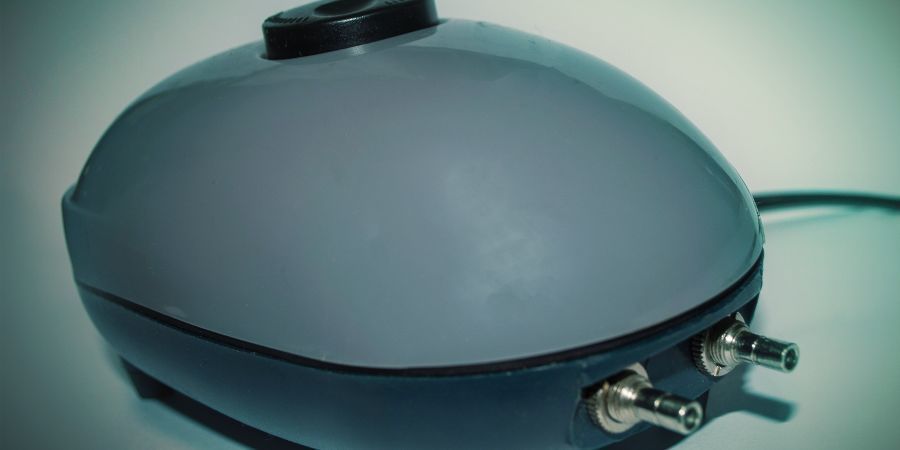
The solution of your DWC reservoir must contain everything your plant needs; that is, enough oxygen and the right combination of nutrients. When it comes to oxygen, you can use an air pump and an air stone to oxygenate your reservoir. Or, you can go for a passive method, without pump, that won’t use up any electricity and will thus save you money. In essence, an air pump provides a flow of oxygen into the reservoir, while the air stone helps disperse the dissolved oxygen throughout the tank.
Using both a pump and a stone is the safest option for granting your plants enough oxygen in the most absorbable form, although you can find success using just the stone too. This passive method can be used alongside the Kratky method, where your net pots are placed at a height that suspends roots 50% in the air and 50% in the nutrient-rich water. In this way, oxygen received from outside the reservoir is enough to keep plants healthy and productive.
STEP 3: NUTRIENTS

Of course, not only must your roots be well-oxygenated, but well-fed too. The nutrient mix in your water solution should of course be adjusted to your strain of choice, although some caution is advised overall. To start, consider feeding your plants with half the recommended dose of nutrients suggested by any product. This is in an effort to gauge how your plant reacts, and because nutrient producers often recommend more than you really need.
Just like growing cannabis any other way, your plant will require different ratios of macronutrients and micronutrients during each phase of growth. If you find that your plants respond fine to your half-feeding schedule and could use a bit more oomph, you can slowly start to increase the dose.
You will likely have to refresh the solution once every week or so. You must also do regular monitoring of both your nutrient and pH levels to ensure your plants have what they need, and can absorb it too. In between refreshing the nutrient solution, you will also have to top up the water level. Do so by adding a solution with approximately half the strength of the initial nutrient solution.
Pro tip: Consider turning your basic system into a slightly fancier bubbleponic growing system—that is, a top-fed DWC system. Essentially, a pump pushes the nutrient solution to the top of the roots, which then trickles down back into the reservoir. This is great for when your plant's roots are not developed enough to reach the solution on their own, and can significantly speed up their growth. Top-feeding is a nice addition, although it is not essential.
STEP 4: CONTAINER
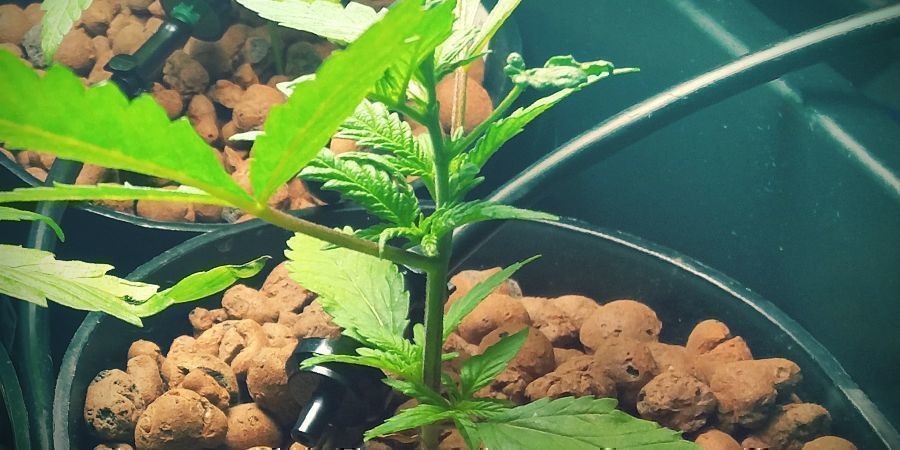
Depending on the size of your operation, you will fit either one plant per individual net pot, or multiple plants into larger perforated trays. Avoid containers that aren’t specialised for hydro systems. While the more experienced cultivators can experiment with making their own pots, novices shouldn’t take any risks. You want to ensure your plants are held securely in place with the roots freely able to grow down into the reservoir.
That said, there are tons of DIY solutions out there. Just keep in mind that, whatever container you do use, it must be big enough for plants to grow, with enough (small) holes for the roots. If the holes are too big, your clay pebbles or other inert medium may fall down into the reservoir. Moreover, make sure any holes you puncture yourself aren’t so sharp that they damage the roots as they search for oxygen.
STEP 5: GROWING MEDIUM
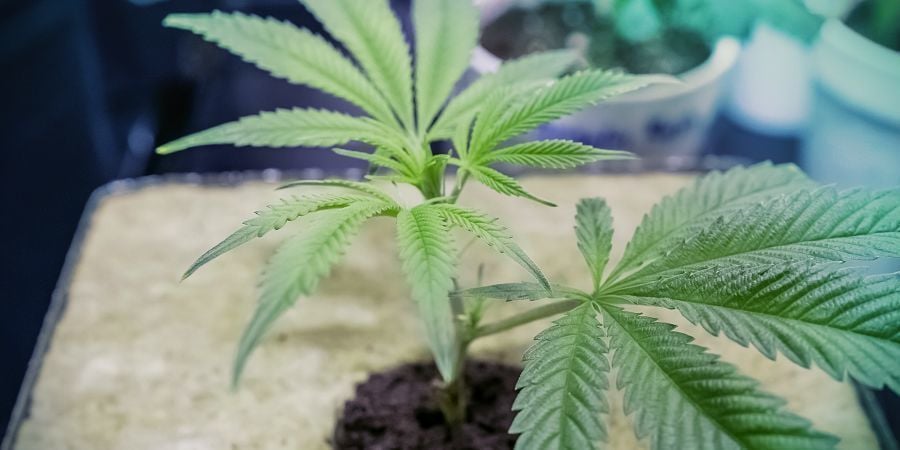
As we mentioned, you will want to plant your seedlings in an inert medium in your net pots. For DWC, clay pellets and rockwool are two common options. You want to choose a medium that provides your seedlings with enough structure, but doesn’t absorb too much moisture. If your medium becomes too moist, it can cause stem rot. Only the bottommost part of the medium should stay wet while the rest remains dry.
If you’re starting from seed, first plant them in a starter cube, wait until your seedlings have developed their first set of “real” leaves (other than cotyledons), then you can place them into your container filled with your growing medium of choice.
Place each net pot above the reservoir so that the base of the container remains in constant contact with the solution, or a few centimetres above depending on the chosen setup. The roots of your cannabis plants will expand in search of nutrients, oxygen, and water, and once they finally hit the solution, you will witness a real growth explosion!
FINAL THOUGHTS/WATCH-OUTS
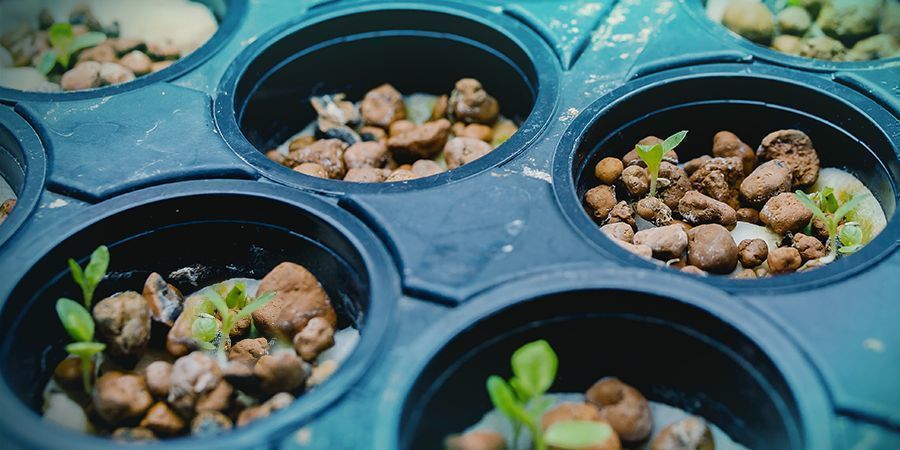
Nowadays, we are witnessing a heyday of hydroponic techniques. Knowledge is spreading and equipment is becoming increasingly affordable and accessible. What was once a prerogative of expert cannabis growers is now a popular choice amongst hobbyists. Yielding abundant crops in a short amount of time, and with fewer resources, would be tempting to anybody! At the same time, you should really consider what your needs and aims are as a cannabis grower to find out whether a DWC system is right for you.
If this is your very first grow ever, we do not recommend starting out with DWC. Instead, we suggest you try soil so you can experience the “natural” process first, and so you can more easily remedy any issues with pH, temperature, etc. The added stress of hydro can put off those new to the art of cultivation, so it’s best to start slow and work your way up.
However, if you have some soil experience and are looking to make the foray into hydro, DWC can be a great way to go. It does require some financial overhead and monitoring, but once you get the hang of it, you may be shocked by how much bigger and more bountiful your buds are. The only way to find out if DWC is right for you is to give it a try!














 United States
United States










